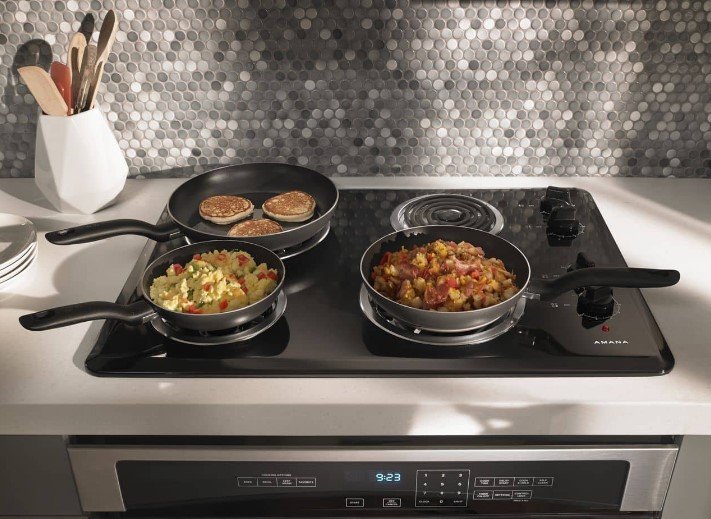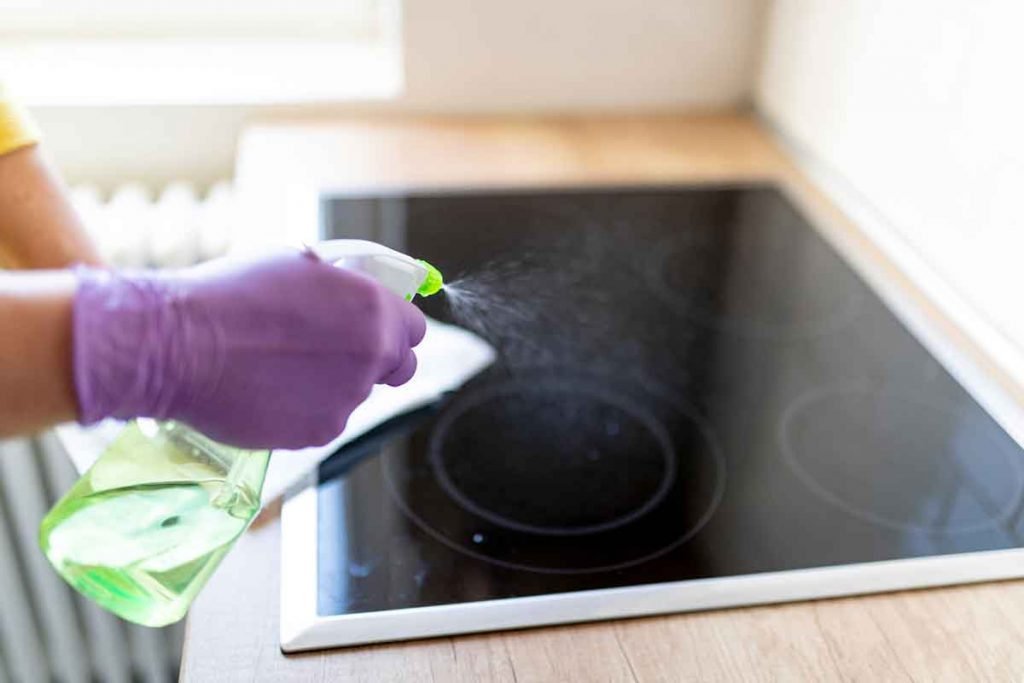Let’s begin with some fun stats:
Over 40 million households in the U.S. use gas for cooking, while 30 million opt for electricity, according to the U.S. Energy Information Administration. That’s pretty close!
While both appliances have their own strong sides and drawbacks, gas appears to take the day. However, electric cooktops, especially induction stoves are on the rise, and these numbers will likely change in a few years.
This article takes a closer look at both electric and gas stoves, looking at the differences as well as the similarities to help you determine which of these you should get today.
Read our review on the best electric stoves.
We also have a review on the best induction cooktops that should interest you as well.
So, Why Electric Stoves? Why Gas Stoves?
Let’s have some quick jabs!
If you want immediate control and lightning-fast heating, gas burners definitely shine. These cookers can crank out extremely high temps in under 5 minutes, compared to the 10+ minutes electric coils can take.
But electric stoves offer perks like smooth, spill-proof surfaces, making cleaning a breeze. A NPD survey found easy cleanup was the #1 most desired range feature.
Gas stoves may save up to $54 yearly on energy costs compared to electric models, according to EnergyStar. But electricity offers greater efficiency – over 70% vs under 50% for gas – helping offset some operating costs.
Whether your team is gas or electric, both serve up the power to cook up food for your hungry crew.
And as we go deeper into this topic, here’s an opinion from the Department of Environmental Health chair at Boston University, Jon Levy:
“Switching from gas stoves to a more efficient electrical appliance is good for indoor air quality….. It’s also good for climate change, and some of the newer technologies are even better for cooking.”
| Feature | Gas Range | Electric Range |
|---|---|---|
| Heating Power | 5,000-15,000 BTU burners heat up very fast | 1,200-3,700 watt elements may heat slightly slower |
| Control | Precise immediate control by adjusting flame height | Requires cycling elements on/off to adjust heat |
| Safety | Open flames and grates are more exposed | Smoothtops contain spills and offer auto shut-off |
| Cleaning | More scrubbing around grates and knobs | Smoothtops wipe down easily |
| Cost | Typically more expensive upfront costs | Usually more affordable upfront costs |
1. Heating Power
Let’s start with traditional gas stove ranges. Gas flames heat up lightning fast, so you can go from cold pan to sizzling wok in 60 seconds. Giving you immediate control to adjust temperatures with the turn of a dial makes gas stoves the winner in this category. Searing steaks or stir-frying veggies requires immediate heat control which gas excels at.
But don’t be too quick to dismiss electric stoves just yet. These cooktops bring some serious power too. Those smooth glass tops hide high-powered burners capable of boiling water with incredible speed.
So, generally speaking……….
Gas burners heat up pots and pans faster, while electric elements may take slightly longer but can achieve very high temps. Power levels range from 5,000-15,000 BTU for gas and 1,200-3,700 watts for electric.
2. Control and Responsiveness
When it comes to immediate control over cooking, gas stoves have a clear advantage. The open gas flames allow you to precisely adjust the temperature just by raising or lowering the flame height. This gives you much finer real-time control compared to electric ranges.
Electric cooktops operate differently – they rely on cycling the electric heating elements on and off to regulate the heat. This doesn’t allow as much real-time finesse to quickly adjust the temperatures up or down. Electric ranges require some preheating time and don’t offer as much immediate control compared to gas.
3. Safety
When it comes to safety, electric stoves may have a slight edge. Their flat surfaces prevent spills from hitting hot coils or burners. Gas stoves are more vulnerable if liquids get near the open flames. Some electric models also have safety features like auto shut-off.
That’s a point for team electricity!
Electric ranges offer flat and smooth surfaces that contain spills near heating elements. Gas burners are more open and exposed. Electric also offers auto shut-off.
4. Ease of Cleaning
Cleaning is another advantage in favor of electric ranges. Those smooth glass surfaces just need a quick wipe-down. Gas stoves require more scrubbing to get around all those dirty grates, knobs, and crevices where food can get trapped. Not very appetizing!
So…..
Electric glass-top ranges wipe down easily and resist staining. Gas surfaces and grates require more scrubbing and maintenance.
5. Cost Considerations
When evaluating the costs of gas vs electric ranges, there are both upfront costs as well as long-term operating costs to consider.
In general, gas ranges tend to cost more upfront compared to similar electric models. Entry-level gas ranges start around $500, while basic electric ranges start around $300. High-end gas ranges can cost $4,000+ compared to electric models topping out around $3,000.
The increased upfront cost of gas appliances is partly due to the additional gas connections and components needed during installation. However, gas stoves make up for this over time through lower operating costs.
Operating costs are where gas shines over electricity. According to EnergyStar estimates, a typical gas range costs $54 per year to run, while an electric range averages around $70 annually. This is because natural gas prices are generally lower compared to electricity rates.
Over 10 years, a gas range may save $200+ in energy costs compared to a similar electric model. However, these savings won’t totally offset the increased initial purchase price. The type of range you choose will impact your short and long-term budget differently.
Environment Aspect
Are electric stoves healthier than gas stoves? Learn more from Vice Dean Michael Bisesi about the differences, and how to protect your family and the environment from potentially dangerous emissions. https://t.co/RZkssk1qgl
— @OSUPublicHealth (@OSUPublicHealth) September 6, 2022
While gas may be tempting for its cooking prowess, there are some concerning health and environmental impacts to note. Recent studies, including one from Stanford University, found gas stoves and cooktops leak methane during use. Without proper ventilation, those invisible methane emissions can negatively impact indoor air quality.
The study estimated gas stoves emit air pollutants equivalent to having 400,000 cars on the road. Yikes! While more research is needed, the findings suggest gas appliances may contribute to respiratory and cardiovascular risks.
So even if you love that open flame finesse, gas comes with some not-so-hot downsides. Making sure your kitchen is well-ventilated can help, but the methane leak factor is worth weighing when deciding between gas or electric. Your lungs may thank you for picking electric!
And there’s more…..
According to scientist based at PSE Healthy Energy, Dr. Eric Lebel, “
“Gas stoves leak small amounts of gas all the time, even when they are off. While these leaks are often too small to smell, they can still impact air quality and increase human health risks in our homes.”
Think your trusty gas stove is harmless? More research says think again. A 2022 study in Environmental Science & Technology made a startling discovery – gas stoves are leaking methane every time you cook!
Over 20 years, those methane emissions from stoves across the U.S. have the same climate impact as 500,000 cars. Yup, our beloved gas ranges are secretly polluting the air.
It gets worse – those methane leaks aren’t the only concern. Gas stoves also release benzene and nitrogen dioxide into your kitchen. An International Journal of Environmental Research and Public Health study linked over 12% of childhood asthma cases to gas stove usage.
So not only are gas stoves contributing to climate change, they could be harming our health, especially little lungs. No one wants an asthma attack with their pancakes!
While more research is underway, the evidence gives serious pause on the risks of gas appliances. Electric stoves may not have that open flame romance, but at least they don’t pump pollution into your breakfast nook. When it comes to health and safety, electric ranges are looking pretty appealing!
Verdict – Who’s the Winner?
So when all is said and done, who wins this fiery kitchen showdown?
It really comes down to your cooking style and priorities…
For quick heating and immediate control, traditional gas stoves takes the day. The open flames and instant heat adjustments provide a familiar experience many chefs prefer. But if you crave state-of-the-art features, digital precision, and smoother cleaning, today’s electric ranges give gas some stiff competition.
Common Questions
What is the difference between gas and electric stove tops?
Gas stove tops use open gas flames to heat pots and pans directly, while electric smooth top ranges use electric heating elements under a flat glass-ceramic surface to heat cookware.
Do professional chefs prefer gas or electric?
Most professional chefs prefer cooking with gas burners because the open flames allow more finesse, immediate control over heat levels, and quicker temperature adjustments.
Does an electric or gas stove cost more to operate?
Gas stoves generally cost less to operate monthly than a comparable electric range. However, gas ranges tend to cost more upfront. The energy source you choose impacts operating costs more than other factors.



